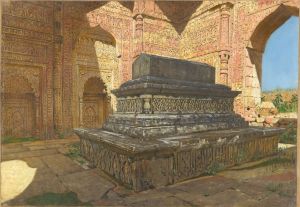
Taj Mahal Mausoleum, Agra
A hand-painted replica of Vasily Vereshchagin’s masterpiece Taj Mahal Mausoleum, Agra, meticulously crafted by professional artists to capture the true essence of the original. Each piece is created with museum-quality canvas and rare mineral pigments, carefully painted by experienced artists with delicate brushstrokes and rich, layered colors to perfectly recreate the texture of the original artwork. Unlike machine-printed reproductions, this hand-painted version brings the painting to life, infused with the artist’s emotions and skill in every stroke. Whether for personal collection or home decoration, it instantly elevates the artistic atmosphere of any space.
Vasily Vereshchagin, a renowned Russian painter and one of the most celebrated war artists of the 19th century, created the painting Taj Mahal Mausoleum, Agra during his travels in India. Vereshchagin was known for his detailed and realistic depictions of historical and cultural subjects, and his works often reflected his extensive journeys through Asia, the Middle East, and other regions. His visit to India in the late 19th century provided him with inspiration to capture the architectural and cultural grandeur of the subcontinent.
The painting Taj Mahal Mausoleum, Agra showcases the iconic Taj Mahal, a UNESCO World Heritage Site and one of the most famous architectural masterpieces in the world. Built between 1632 and 1648 by the Mughal Emperor Shah Jahan as a mausoleum for his beloved wife Mumtaz Mahal, the Taj Mahal is renowned for its intricate white marble design, symmetrical layout, and stunning reflection in the surrounding water features. Vereshchagin’s work captures the monument’s serene beauty and its cultural significance as a symbol of love and devotion.
Vereshchagin’s artistic style is characterized by meticulous attention to detail and a commitment to authenticity. In this painting, he likely sought to portray the Taj Mahal with precision, emphasizing its architectural elements and the surrounding environment. His use of light and shadow often added depth and realism to his works, and this painting is no exception. The depiction of the Taj Mahal in Vereshchagin’s art reflects his admiration for the craftsmanship and artistic achievements of the Mughal era.
The painting is part of Vereshchagin’s broader body of work that documents his travels and observations of different cultures and historical landmarks. His Indian series includes other notable works that highlight the region’s rich history and architectural heritage. Vereshchagin’s paintings were widely exhibited during his lifetime, and they continue to be appreciated for their historical and artistic value.
While specific details about the current location or ownership of Taj Mahal Mausoleum, Agra are not readily available, the painting remains an important example of Vereshchagin’s ability to capture the essence of the places he visited. His works serve as a visual record of the 19th-century world and offer viewers a glimpse into the cultural and historical landscapes of the time.











